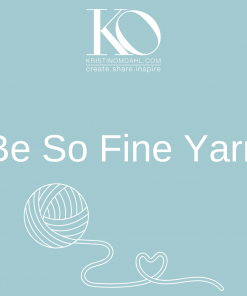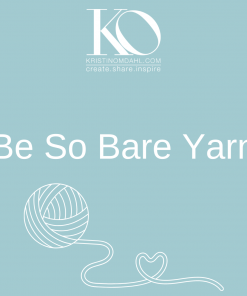Top 12 Tips for Crocheting with Thin Yarns by Kristin Omdahl
Thinner yarns (lace, fingering and sport weight) can be used in a variety of ways to make beautiful clothing and accessories. If you are used to much thicker yarns (dk, worsted, aran, bulky and chunky) there are a few tips I suggest for making the transition enjoyable.
1. Choose your project wisely.
Start with an easy pattern and simple stitches, or choose a pattern you are already familiar with that has stitches you already know well. Or, if the desired pattern is brand new to you, try learning only one variable at a time. Learn the stitches and techniques with a thicker yarn you are comfortable crocheting with already. Once you feel comfortable with the project, then go back and try it again with the thinner yarn. Or, crochet a swatch using basic stitches to get the feel of the crochet without the pressure of following a pattern.
2. Choose a comfortable hook.
Generally speaking, the smaller the yarn, the smaller the hook and fabric, the tighter your grip. Try looking for a hook with a handle larger than the shaft of the hook for a more comfortable fit and to avoid straining your hand. Sometimes these are marketed as ergonomic hooks. But different strokes for different folks, right? Test out a few different kinds and see what works best for you. There are different styles of hooks (inline vs tapered hook); different materials (bamboo, wood, metal, plastic); different lengths; different price ranges; and more. There is no right or wrong type of hook to use, as long as you are getting the results and experience you desire.
3. Choose the correct hook size.
This can depend on what you are making. If you want to make a solid fabric, try using a hook that is suggested on the yarn label. If lace is your desire, try using a hook larger than what is suggested on the yarn label. If you are making a specific pattern that calls for the specific yarn (or you have substituted correctly) then follow the suggested hook size for the pattern. But that too is only a suggestion. If the pattern requires gauge for sizing, whatever hook size works for you to get gauge after blocking is the right hook size for you for this specific yarn and project combination.
4. Learn how to hold your hook and yarn.
How you hold your hook with thin yarn may be somewhat different from how you hold your hook with thicker yarn. You may need to hold tighter, or be more aware of the tension on the yarn. Whether you need to adjust and make changes or not, just be aware that it is ok. I know it is tempting to compare yourself to others, but there is no right or wrong way to crochet, as long as you get the results and experience you desire.
5. Learn how to recognize your stitches.
Until a loose, lacy fabric is blocked, the anatomy of your stitches can be difficult to recognize. Take your time, mark your work with as many color-coded stitch markers as necessary, and set your work down on a flat surface to gain more clarity.
6. Find good lighting.
Smaller projects require a closer look. To avoid eye strain, make sure you have a comfortable space with good lighting. Or work with lighter colors until you can find better lighting.
7. Take breaks.
Any time you do something with focus and concentration, it can be easy to lose track of time. But sitting in the same position for too long at a time can cause all kinds of discomfort. If you are having difficulty remembering to take breaks, set the timer on your phone, a clock or an appliance. I like to set reminders every hour or so to walk around, shake out my hands and feet, and refill my water. Hydrating is good advice, period!
8. Learn how to block.
Thinner yarns, especially when used with larger hooks to create lace, will look quite loose until you block your project or gauge swatch. Lacier and looser crochet will be more affected by water than densely stitched projects. Gauge is more critical for lace and other loosely crocheted projects because of the difference between before and after blocking gauge measurements.
9. Learn how to weave in your ends.
Weaving in your ends is a necessary part of every crochet project. However, with thinner and lacier fabrics, it can require a little more finesse. Make sure your ends are sufficient in length before cutting and fastening off (around 6 in. or so) and gently work the yarn back and forth in multiple directions for several inches before carefully snipping the last bit off, close to the fabric. Any section of the fabric that is dense will be easier for weaving in ends: for example, a seam; a cluster, shell or other textured stitch; or the wrong side of the fabric.
10. Relax and have fun.
It is human nature to get a little anxious when you are trying something new. It is ok to make mistakes! That is part of the learning process. The most important thing to remember is this is a hobby and supposed to be fun. If you’re feeling frustrated, take a break. Go for a walk, take a cold shower, or chat with a loved one. A fresh perspective can inspire.
11. Practice.
Practice makes perfect, no matter what it is you are wanting to learn. Don’t expect yourself to be perfect – perfection does not exist! As long as you don’t give up, you will improve your skills with practice!
12. Pat Yourself on the Back.
Learning something new is exciting; don’t forget to pat yourself on the back and share your joy and excitement with others. Remember that yo are your own worst critic – and probably the only person who has any idea what the original pattern looked like. It’s perfectly fine to improvise and create something new!
Browse Kristin Omdahl Yarns in the #1 fingering weight category here:
#1 Fingering Weight Yarn
Browse Kristin Omdahl Yarns in the #2 sport weight yarn category here:
#2 Sport Weight Yarn
#2 Sport Weight Yarn






